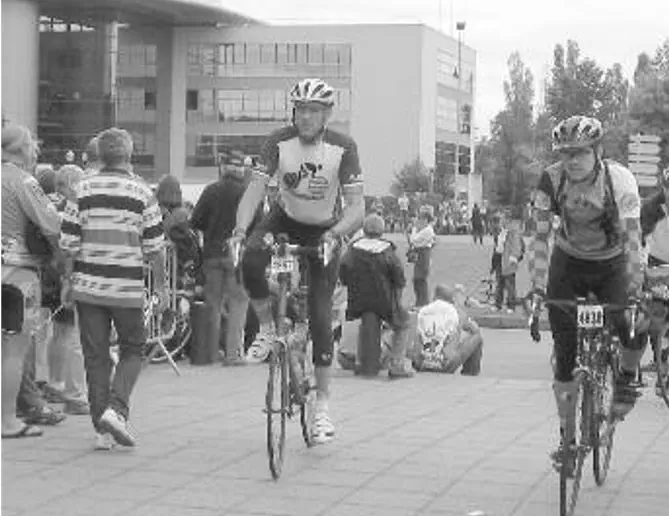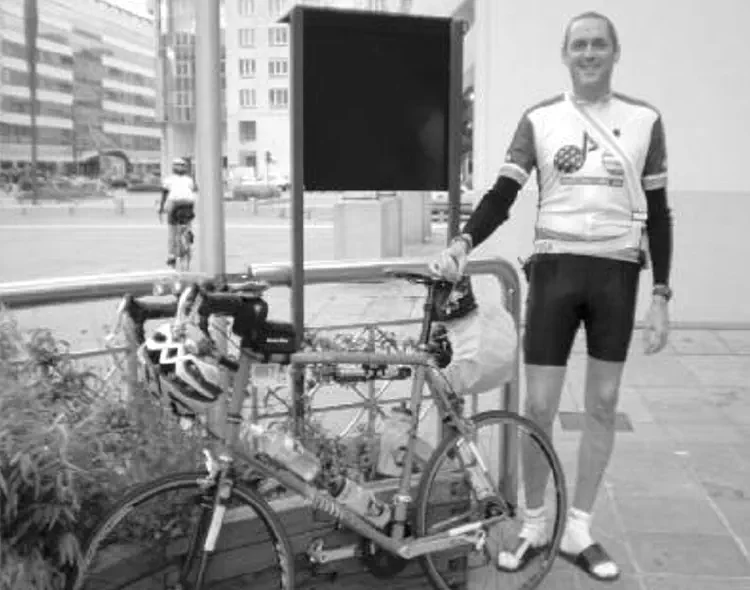For the Slow Rider: Practical Strategies for PBP
We offer you a repost of an article by Greg Olmstead, published in American Randonneur Magazine in 2015.
In 2007, I approached PBP with a set of strategies for handling the physical and mental challenges based on the fact that I’m not a fast rider. Simply endeavoring to ride faster wasn’t realistic. To offer a bit more context, this was my first PBP, I was 45 years old, and Iweighed 220 pounds. I knew that I wasn’t going to do a fast PBP, but I finished my 600K ride in 36:12, and I naively estimated that I could double that time, add a couple hours for laughs, and finish in 75 to 80 hours. It turned out that my finish time was 88:50, primarily because a 1200K ride is very different than a 600K. A 1200K ride requires strategies, time management, and adaptability on a higher level than a 600K.
PBP Strategies for the slow and steady:
1. Make the most of your time off the bike because it will affect your time on the bike.
For PBP, there are only 90 hours and you can only spend them a few different ways: time riding the bike, time off the bike while in a control, and time off the bike while on the course. As a slower rider, I knew that I would have less time off the bike. So my goals were to (a) stay above a target speed while on the bike, (b) minimize the time spent at controls, and (c) minimize time taking breaks along the course. It turned out that I didn’t define my goals well enough. It’s one thing to minimize one’s time at a control, and it’s another to maximize the utility of your time while in the control. It’s a small but important distinction, as I’ll explain presently.
Troughout the first day, I grabbed some shuteye periodically, which usually meant putting my head down on a cafeteria table. Although I slept, strictly speaking, it wasn’t a restful sleep. I rested my eyes but the sitting position never let my legs recover. Tey always felt as heavy after as they did before. So my average moving speed decreased steadily. And although I did get a chance to lie down for a nap (in a bus shelter), it was only for 30-45 minutes. It wasn’t until the third day that I decided I had had enough, and paid for a bed and shower. After my shower, I put my head on my pillow, closed my eyes and had two hours of wonderful, dreamless sleep. When I woke up and got back on the road I felt so reinvigorated; I was kicking myself for not having rented a bed sooner. It wasn’t a budget issue. I simply felt that I didn’t have the luxury of time to sleep for two hours in a bed. After PBP, I feel that sleeping two hours in a bed is far more beneficial than taking four, 30-minute naps in cafeterias. It would be the same amount of time off the bike, but I was able to ride faster after sleep in a bed.
2. Your brain needs a backup system.I used index cards.
As fatigue accumulated, I found it harder to think clearly and quickly. I had a taste of this in my 400K and 600K qualifiers. So, before leaving for PBP I prepared one 3”x5” index card for each control on the route. On each card, I wrote the name and number of the upcoming control (e.g. #6 Brest), the distance to the control, the closing time of the control, and any special instructions for what I should do while at the control. For example, I may have needed to take items from my drop bag, or put things back into it, have a recovery drink, and so on. My goal was to pre-think my tasks and put them on index cards so that I didn’t have to think at the controls. Tis was an attempt to minimize time off the bike, but it was not a flawless system (see below).

At the Loudéac control, I pulled up and parked my bike at a bike rack that I thought would be easy to find after I had a bite to eat. As it turns out, the bike rack was on the opposite side of the parking lot from the bag drop. Having ridden 24 hours with only one nap, I was unable to conclude that I’d be better off parking my bike right next to the drop bags. So, when it came time to add carb fuel to my bottles, I walked across the parking lot to get my bottle, back across the parking lot to the drop bag to get the carb fuel, over to the water fountain to fill the bottle, then over to the bike to put the bottle in the cage. Ten I repeated the process with the second bottle. It was comically inefficient, but it was all I could handle mentally.
Not only was I supposed to fill my bottles at the control, I was also supposed to take carb fuel from my drop bag and put it on my bike. Tat didn’t happen, simply because I forgot to do it even though it was written down on the index card. I left the carb fuel in my drop bag and headed off into the night. It wasn’t until I was about fifteen miles down the road that I realized what I had done, but I felt I couldn’t afford the time it would take to turn around and retrieve it. I was simply too dazed to follow my written instructions. Te solution, which occurred to me later, is to use musette bags and store them in my drop bags. Ten, I’d just have to rememberto take one musette bag filled with provisions instead of many things. With a musette bag, I’d have as much time as I wanted or needed (while riding)to sortthrough its contents and figure out what I should do with them, instead of having just a few minutes at the bag drop.
On the other hand, the cards did make it easy for me to access helpful information, so there was no need to remember various data throughout the ride. Te two most useful elements of these cards were control closing times and the information telling me where each control was in the whole sequence. As I finished with a control, I would throw away the card for that control, and this act helped me to feel that I was making substantial progress. Tere were only 14 controls, so discarding card #9 and turning my attention to card #10 was a great mental boost. Te closing time of the control was perhaps the best feature of these cards. Very early on I resolved not to leave a control after it closed. In practical terms, doing this would have meant that I was playing catch up to get to the next control, and I felt it was unwise to get into that space mentally. It was easy to stick to this plan early in the ride, but as time wore on and I slowed down, it became harder. When I arrived at a control, I’d look to see when it closed, compare that to the current time, then tell myself I had X amount of time to get my stuff done and leave.

3. Don’t underestimate the benefits of being happy.
I don’t remember talking to anyone at PBP who didn’t suffer at some level. And the longer one’s out on the road, the more opportunities there are to suffer. During any event, I spend time nurturing a positive frame of mind to counteract the inevitable suffering. And the first and easiest way to change my frame of mind is through food. While I was happy to eat what was offered at the cafes and markets, when it was cold and raining at 3am, I would think how much I would really like a peanut butter and jelly sandwich instead of another baguette and brie. It occurred to me later that it would have been possible to take individual packets of peanut butter, and put them in my drop bag: not enough to fuel the whole ride, but one or two packets as a self-administered CARE package. I also might have enjoyed turkey jerky, chocolate-covered mint Oreos, or a cold root beer, all of which are highly portable and non-perishable. I wish I had packed just a couple of these things to put into my drop bags.
The other thing I did to maintain a positive frame of mind was to take a little time to chat with volunteers and roadside spectators. I took California Triple Crown patches to hand out to control volunteers, and a fistful of RUSA lapel pins to hand outto roadside spectators. Every time I gave out one of these gifts, I would use my best high school French for a minute with the people I met. Tey were always so positive and encouraging that I felt I owed it to them to keep going, even when it was very difficult to do so.
Other riders in the event can be helpful, whether or not you strike up a conversation. When I was able to chat with people, I was able to take my mind off the ride for a bit, which was always a welcome relief. And even if I didn’t talk with others, sometimes I would use groups ahead of me to help me lift my pace just a hair beyond what I would have been riding were I alone. When I ride solo it’s easy to fall into a lull, which, in practical terms, means a slower pace.
This was truly a physical and mental challenge in a league of its own. Perhaps my experiences will be encouraging and allow you to plan with additional practical insight. Do what you can to make the most of your time on and off the bike, and hopefully you will have the time of your life.
